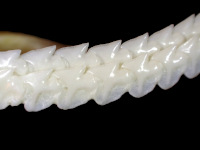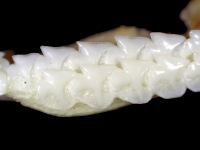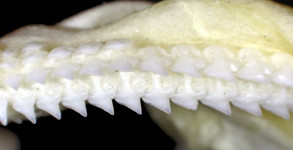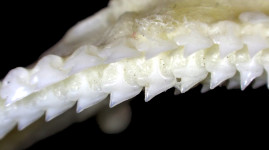Centrophorus westraliensis
White, Ebert & Compagno, 2008
Western gulper shark
Classification: Elasmobranchii Squaliformes Centrophoridae
Reference of the original description
Description of two new species of gulper sharks, genus Centrophorus (Chondrichthyes: Squaliformes: Centrophoridae) from Australia. CSIRO Marine and Atmospheric Research Paper, 22, 1–22
Description of two new species of gulper sharks, genus Centrophorus (Chondrichthyes: Squaliformes: Centrophoridae) from Australia. CSIRO Marine and Atmospheric Research Paper, 22, 1–22
Image of the original description
.jpg)
Western Gulper Shark, Centrophorus westraliensis, White, Ebert & Compagno, 2008 © Pacific Shark Research Center at Moss Landing Marine Laboratories (MLML)
.jpg)
Western Gulper Shark, Centrophorus westraliensis, White, Ebert & Compagno, 2008 © Pacific Shark Research Center at Moss Landing Marine Laboratories (MLML)
Types
Centrophorus westraliensis
Holotype: CSIRO: H 2625-06; Paratype: CSIRO: H 2625-05; CSIRO: H 2606-01; CSIRO: H 2580-01; CSIRO: H 2357-03; CSIRO: H 2358-01;
Centrophorus westraliensis
Holotype: CSIRO: H 2625-06; Paratype: CSIRO: H 2625-05; CSIRO: H 2606-01; CSIRO: H 2580-01; CSIRO: H 2357-03; CSIRO: H 2358-01;
Description :
Citation: Centrophorus westraliensis White, Ebert & Compagno, 2008: In: Database of modern sharks, rays and chimaeras, www.shark-references.com, World Wide Web electronic publication, Version 01/2026
Please send your images of "Centrophorus westraliensis" to info@shark-references.com
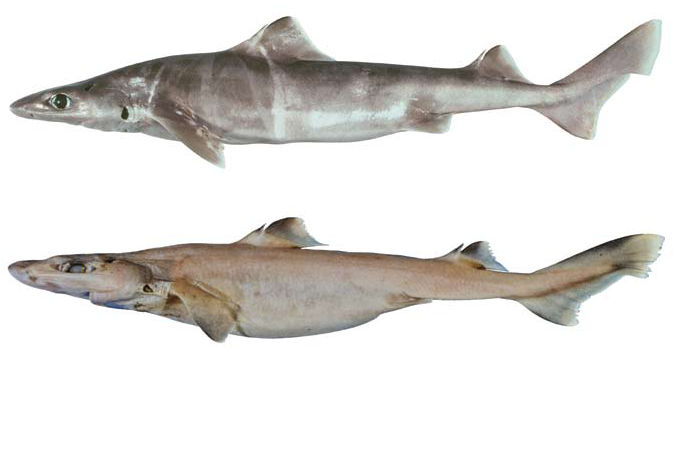
Lateral view of Centrophorus westraliensis sp. nov.: female paratype (CSIRO H 2606–01, 774 mm TL, fresh); immature male paratype (CSIRO 2358–01, 371 mm TL, preserved).; In: White, W.T. & Ebert, D.A. & Compagno, L.J.V. (2008): Description of two new species of gulper sharks, genus Centrophorus (Chondrichthyes: Squaliformes: Centrophoridae) from Australia. CSIRO Marine and Atmospheric Research Paper, 22: 1-22

Lateral view of Centrophorus westraliensis sp. nov.: female paratype (CSIRO H 2606–01, 774 mm TL, fresh); immature male paratype (CSIRO 2358–01, 371 mm TL, preserved).; In: White, W.T. & Ebert, D.A. & Compagno, L.J.V. (2008): Description of two new species of gulper sharks, genus Centrophorus (Chondrichthyes: Squaliformes: Centrophoridae) from Australia. CSIRO Marine and Atmospheric Research Paper, 22: 1-22
Common names
 Western gulper shark
Western gulper shark
 Western gulper shark
Western gulper shark
Short Description
This moderate-sized species has the following set of adult characters: length of pre-second dorsal 63.8-64.9% TL, 8.8-9.7 times dorsal-caudal space; length of pre-first dorsal 31.3-32.7% TL; interdorsal space 20.3-21.5% TL, 2.8-3.1 times dorsal-caudal space; dorsal-caudal space 6.7-7.3% TL, 4.4-4.9 in pectoral-pelvic space; long and moderately robust head, its length 23.2-24.7% TL, 3.1- 3.2 times mouth width, its width 11.7?12.8% TL, 5.1-5.5 in pre-second dorsal length; width at anterior of nostrils 7.1-7.6% TL; long snout, its preoral length 10.9-12.4% TL, 2.0-2.2 times head height at anterior of mouth, 1.4-1.6 times mouth width; horizontal preorbital length 7.0-7.8% TL; horizontal prenarial length 4.5-4.9% TL; moderately large mouth, its width 7.6?7.8% TL; large pectoral fin, its anterior margin 12.9-14.2% TL, 2.6-2.8 times base length; large caudal fin, its dorsal caudal margin 17.4-20.2% TL; 2.6-2.9 times dorsal-caudal space; moderately-sized first dorsal fin, its height 5.5-6.4% TL, with relatively robust spine, its base width 1.1-1.2% TL; dorsal fins of juveniles have a distinct blackish oblique blotch anteriorly and a white blotch on the upper posterior margin; in adults a less distinct dark blotch which is usually still apparent in fresh specimens and with white blotch restricted to a narrow white posterior margin which can be indistinct in larger preserved specimens; females and an immature male with upper teeth strongly oblique, similar in shape, but much smaller than lower teeth; 38/29.teeth count in holotype; adults with flank denticles flat, not overlapping, with scalloped edges; 112-117 (mean 115.3) total vertebral centra; 55-57 (55.8) monospondylous precaudal centra; 29-33 (31) diplospondylous precaudal centra; 85-88 (86.8) precaudal centra; 27-30 (28.5) diplospondylous caudal centra [3336].
This moderate-sized species has the following set of adult characters: length of pre-second dorsal 63.8-64.9% TL, 8.8-9.7 times dorsal-caudal space; length of pre-first dorsal 31.3-32.7% TL; interdorsal space 20.3-21.5% TL, 2.8-3.1 times dorsal-caudal space; dorsal-caudal space 6.7-7.3% TL, 4.4-4.9 in pectoral-pelvic space; long and moderately robust head, its length 23.2-24.7% TL, 3.1- 3.2 times mouth width, its width 11.7?12.8% TL, 5.1-5.5 in pre-second dorsal length; width at anterior of nostrils 7.1-7.6% TL; long snout, its preoral length 10.9-12.4% TL, 2.0-2.2 times head height at anterior of mouth, 1.4-1.6 times mouth width; horizontal preorbital length 7.0-7.8% TL; horizontal prenarial length 4.5-4.9% TL; moderately large mouth, its width 7.6?7.8% TL; large pectoral fin, its anterior margin 12.9-14.2% TL, 2.6-2.8 times base length; large caudal fin, its dorsal caudal margin 17.4-20.2% TL; 2.6-2.9 times dorsal-caudal space; moderately-sized first dorsal fin, its height 5.5-6.4% TL, with relatively robust spine, its base width 1.1-1.2% TL; dorsal fins of juveniles have a distinct blackish oblique blotch anteriorly and a white blotch on the upper posterior margin; in adults a less distinct dark blotch which is usually still apparent in fresh specimens and with white blotch restricted to a narrow white posterior margin which can be indistinct in larger preserved specimens; females and an immature male with upper teeth strongly oblique, similar in shape, but much smaller than lower teeth; 38/29.teeth count in holotype; adults with flank denticles flat, not overlapping, with scalloped edges; 112-117 (mean 115.3) total vertebral centra; 55-57 (55.8) monospondylous precaudal centra; 29-33 (31) diplospondylous precaudal centra; 85-88 (86.8) precaudal centra; 27-30 (28.5) diplospondylous caudal centra [3336].
Size / Weight / Age
90.9 cm TL (female)
90.9 cm TL (female)
Remarks
shark-references Species-ID=1263;
shark-references Species-ID=1263;








